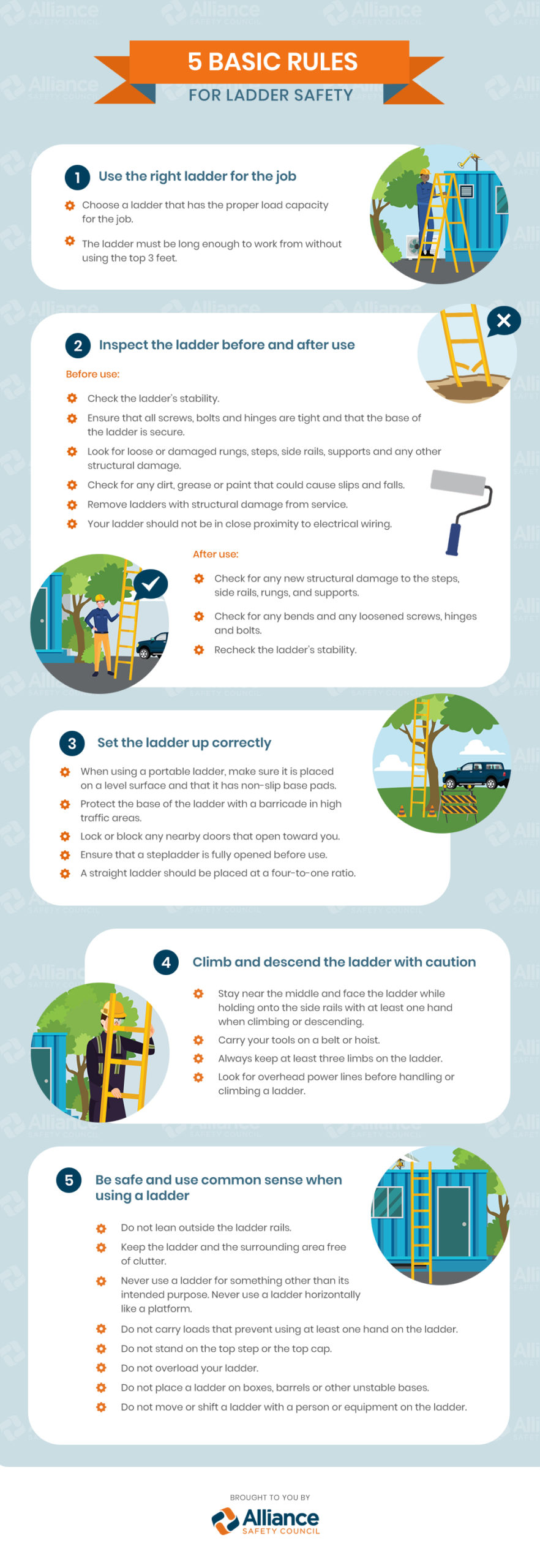Falls from ladders are a leading cause of workplace fatalities. By following the basic rules of ladder safety and having a fall prevention plan in place, serious accidents can be eliminated or substantially reduced.
Here are five basic rules for ladder safety.
1.Use the right ladder for the job
It is important to choose a ladder that has the proper load capacity for the job. Consider your own weight as well as the weight of your equipment, tools and materials. The ladder must be long enough to work from without using the top 3 feet.
2. Inspect the ladder before and after use
Before use:
- Check the ladder’s stability.
- Ensure that all screws, bolts and hinges are tight and that the base of the ladder is secure.
- Look for loose or damaged rungs, steps, side rails, supports and any other structural damage.
- Check for any dirt, grease or paint that could cause slips and falls.
- Remove ladders with structural damage from service.
- Your ladder should not be in close proximity to electrical wiring.
After use:
- Check for any new structural damage to the steps, side rails, rungs and supports.
- Check for any bends and any loosened screws, hinges and bolts.
- Recheck the ladder’s stability.
3. Set the ladder up correctly
Ladder placement is important. When using a portable ladder, make sure it is placed on a level surface and that it has non-slip base pads. Protect the base of ladder with a barricade in high traffic areas. Be sure to lock or block any nearby doors that open toward you. If you’re using a stepladder, ensure that it is fully open before use.
A straight ladder should be placed at a four-to-one ratio, which means that the base should be 1 foot away from the wall or vertical surface for every 4 feet of height to the point of support. When climbing onto a roof or platform from a ladder, the ladder must extend at least 3 feet above the edge and be tied off at the top.
4. Climb and descend the ladder with caution
Stay near the middle and face the ladder while holding onto the side rails with at least one hand when climbing or descending. Carry your tools on a belt or hoist and always keep at least three limbs on the ladder. Look for overhead power lines before handling or climbing a ladder.
5. Be safe and use common sense when using a ladder
- Do not lean outside the ladder rails.
- Keep the ladder and the surrounding area free of clutter.
- Never use a ladder for something other than its intended purpose. Never use a ladder horizontally like a platform.
- Do not carry loads that prevent using at least one hand on the ladder.
- Do not stand on the top step or the top cap, and do not overload your ladder.
- Do not place a ladder on boxes, barrels or other unstable bases.
- Do not move or shift a ladder with a person or equipment on the ladder.
FFor easy reference, we’ve created this handy infographic on ladder safety.

Source: https://safety.nmsu.edu/

